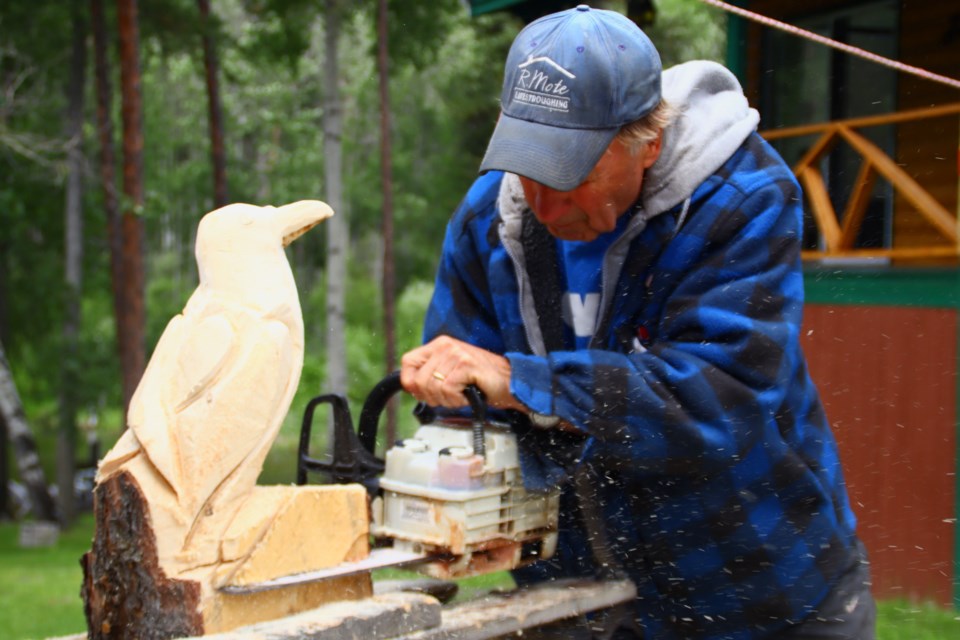Some artists work with paint. Others work with pencils or pastels. When Beaner Deans wants to express himself, he looks for something with more horsepower.
Beaner creates sculptures and carvings from scavenged or found wood, creating his pieces by using chainsaws to shred them into shape. Those pieces range from large statues to smaller, more detailed works, often involving animals found in the north, images close to locals’ hearts or even Beaner’s own interests.
Beaner doesn’t like being called an artist or calling his pieces art - he prefers to be seen as a chainsaw carver - but his carvings could be classified as such, often featuring intricate designs, flashy colours or smooth, close-to-lifelike contours and curves. When looking at his pieces at his Schist Lake home, you'd almost think Beaner had sanded down chunks of wood carefully with his bare hands, painstakingly, to get the look his pieces are known for - and that’s when you'd hear the chainsaw revving up in the back yard.
“BRRRRRRRRTTTTTRRTTTTTT” goes the tool of Beaner’s trade, ripping through a trunk of willow and kicking up a cloud of sawdust. Today, Beaner is carving out a raven, one of his most requested works and one of his favourite subjects, using the saw to do the fine details around the bird’s head and beak. Beaner does much of his work outside when the weather allows - in the quiet time after he’s done carving, ravens can be heard squawking nearby, looking at Beaner creating one of their own from the trees they're perched in.
Beaner uses other implements on occasion, including trowels, an angle grinder and a router with a quarter-inch bit, but he comes back to the chainsaw - he has no fewer than three that he uses for his work. For his latest piece, Beaner uses an old Stihl saw with a short blade - one used more for precision than other, bigger saws.
Beaner is now, by his estimation, “a 75-year-old teenager” - he estimates he got started carving about a decade ago. Since then, he’s produced between 200 to 300 pieces - he estimates at his peak, he can make about 40 pieces a year if he sticks with it and has a steady supply of wood, ranging from signs carved from wood in relief to sculptures of animals and other bases.
“I learned that I get really tired after a while,” he said.
“My back gets sore and my arms get tired, but from doing that sawing, you get very strong forearms - but you want to keep going because it doesn’t get done unless you do it.”
Beaner’s hobby began when he picked up a wooden statue of an eagle at an event - he liked the statue, but something annoyed him about the statue’s beak.
“Everything was square - the head was square, everything was square,” he recalled.
Beaner went home and tried to make the beak a bit more round and lifelike, finally getting there after digging out a saw from his shed. After the sawdust flew, Beaner was left with a statue looking more to his liking - and, after the prodding of a friend afterward, a new hobby.
“He said, ‘How did you make out on your eagle?’ I said, ‘Well, it’s round,’” Beaner said.
Since getting started, Beaner has developed an instinct for finding art within the wood. Any experienced sculptor will say they can sometimes see a piece inside the item they carve, whether it’s a slab of marble, a pile of clay or anything else. When Beaner looks at at a chunk of wood, it’s the same way - years of working with wood has taught him which ideas work, which don’t and how to properly use the material he has.
“It’s hard to get the depth. It’s hard to get that - sometimes you screw up while carving. With wood, if you don’t take too much, you’ve always got some more to take. I start little and then I’ll think, ‘oh, this nose isn’t long enough,’ or ‘oh, I gotta put the eyes back further’, something like that,” he said.
“Most of it is trial and error.”
Using material like downed trees or chunks of wood gathered by friends, Beaner has been able to learn more about the subjects he carves and the wood he uses to carve them. The stump of an old mountain ash tree, with three branches cut from it, became a trio of owls, a small family.
“This little owl,” Beaner says, holding the piece and recounting a conversation with a friend, “was a stump with three things shooting off of it. I said, ‘See that little stump there? That’s going to be mama owl there, then this small one will be baby owl in her wings, sitting on her tummy. This one over here’s going to be a papa owl looking out for them.’ He says, ‘How the hell do you see that?’ and I thought ‘I wonder what I can do with that.’”
“I’ve found that I actually understand the grain of the wood, which angles to make a bird’s beak so it’s stronger. I find that if I can sell something, I stay interested.”
That knowledge has also come from artists elsewhere. Beaner mentions that his carvings of faces improved over the years after speaking with artists from out west.
“I tried to do some faces, then I got a lesson from a guy out in B.C. - he said faces are like a 45 degree angle - if you stand in the corner and face it, your cheeks will touch the corner and your nose will be right in the corner, but you don’t see a face like that. You’ve got to try and figure that into your carvings,” he said.
A common theme within Beaner’s works is his own motto - “Teach Peace”, he says, incorporating the motto within several of his own pieces.
“That’s my motto. I’m not a preacher or anything, but I do like the fact that we, most of the time, have peace,” he said.
Some of Beaner’s pieces are done on commission, one of the latest of which was a piece involving a penguin cradling a baby penguin at their feet. Another one is a wooden cross for a friend who recently lost a loved one. Others still involve frogs made out of scrap wood, showing smoking a joint with a cannabis leaf above it - Beaner’s creativity ebbs and flows towards what interests him or what people ask him to do.
Sometimes, the material he has dictates what piece he makes - a chunk of driftwood given to him by a friend became something he calls “the thing”, with a pair of eyes and a long tongue, then gets mounted onto a walking stick. Some of his pieces sit on Flinty’s Boardwalk, having been mounted there last year.
“You kind of use your imagination,” he said.
Beaner sells his wares at area craft sales, sometimes heading out of town to sell the pieces. He doesn’t have business cards yet - he takes orders for pieces via his own personal Facebook page.
Not everything he carves is for sale though - one of his passion projects, a seven-foot-tall fully-functional standup electric bass, stays with him unless he brings it out to show off at a local concert. A musician for the past six decades, Beaner plays that bass whenever he gets a chance.
Another project is a statue of his late mother and her twin sister, one he plans to incorporate into a larger piece he’s making in her memory. Another future goal of Beaner’s is to carve a large wooden pirate ship relief carving, similar to one he found in the Norwood Hotel in Winnipeg, complete with intricate details like individual sailors cut from the wood.
Much of Beaner’s work is done with fallen trees - he hopes that his work can also bring awareness to the environment and conservation.
“I love the trees. When I see what I can make out of a tree, it gives me a big reason to preserve forest so that there are trees to do stuff with, not just my stuff, but with other things too,” he said.
“The forest is very important. If we have no forest, we have no planet. Although I’m cutting a tree, I’m still preserving too - I don’t overdo it and I try to get fallen or dead trees - those are the ones I try to use. It’s about being careful about what you use.”




